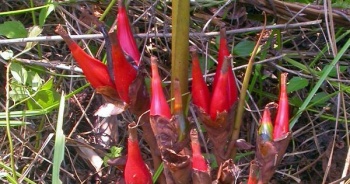Madagascar Cardamom
From Wikiwel
Other Names : Aframomum angustifolium, Guinea Grains, Longoza Plant, Mlelgueta Pepper, Maniguette Fine
Madagascar cardamom is a herbaceous perennial plant producing dense stands of leafy stems 1.5 - 4 metres tall from a tuberous rootstock. The fruits and seeds are gathered from the wild for local use as a food and condiment. The plant is occasionally cultivated for its edible fruit and seeds.
Special Precautions of Madagascar Cardamom
- No internal use known for this essential oil, to avoid except possible medical prescription.
- Avoid during pregnancy and lactation and in children under 6 years.
- Do not use pure on the skin (except 2-3 drops in localized use, for example on the solar plexus, the internal face of the wrists ...). For dermal use, dilute in a vegetable oil or other suitable support (cream ...).
- Certain natural compounds contained in this essential oil may present a risk of allergy to certain sensitive persons when the essential oil is incorporated into a cosmetic composition (according to the 7th Amendment of the European Directive on cosmetic products (2003/15 / EC )): Limonene.
- As a general rule, always test the application of your preparation, in the crease of the elbow, at least 48 hours before using it.
- Avoid contact with eyes and mucous membranes.
- Keep out of the reach of children.
Health Benefits and uses of Madagascar Cardamom are
- The fruits are eaten raw. The sweet, sugary pulp is frequently eaten as a snack - it is particularly liked by children. The seeds are crushed and used as a spice like pepper. They are also used in the Near East as an admixture to coffee
- The crushed seeds are boiled with the roots of Piper capensis and drunk as an aphrodisiac.
- In Congo, the seeds are chewed to fight intestinal worms.
- In Nigeria, stems are used to make ties that tie sorghum. The whole plant is rich in aromatic components and it is mainly the leaves that are distilled to give the essential oil.
- In Madagascar, these aromatic leaves are used in traditional medicine in decoction to fight the cough.
- The seeds are crushed and applied to the skin to treat dermatoses and infections with Pytirisais versicolor.
- Recently, research has shown that the seed extracts of Aframomum angustifolium are rich in labdane diterpenes and their efficacy on skin problems. In addition, an extract of these seeds has proved an anti-age effect in cosmetics.
- Moreover, its interesting content of beta-caryophyllene suggests a good anti-inflammatory activity, while its richness in terpenic esters explains its powerful balancing effects on the nervous system.
- Rich in pinene, this oil will also be a good choice for cleansing the air and toning the body.
- An excellent synergy to revitalize the body and the morale in times of stress!
- Usde for stress and nervous fatigue
- Sleep disorders, insomnia, nightmares
- frustration
- Blocking the solar plexus
- To create a relaxing atmosphere and "cocooning" while cleansing the air:
